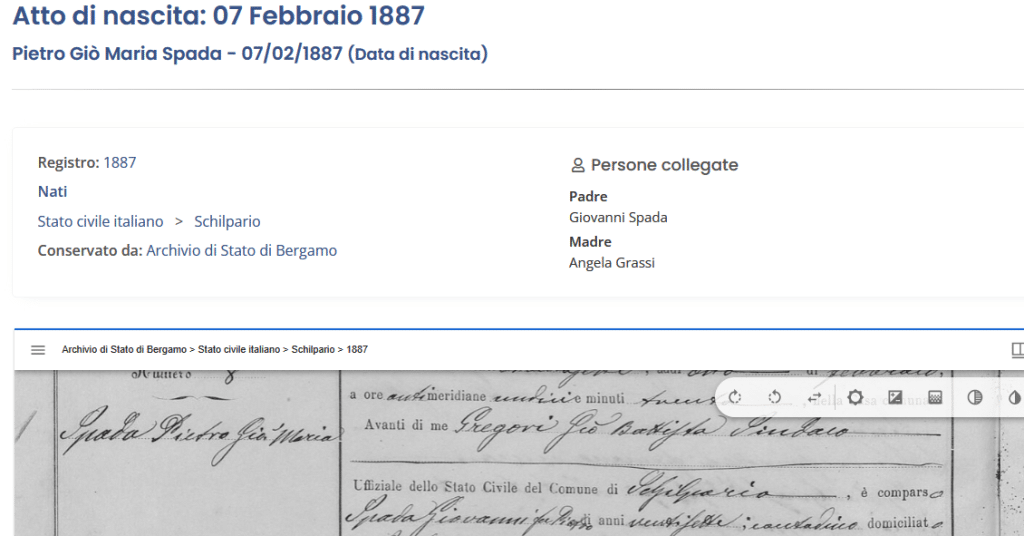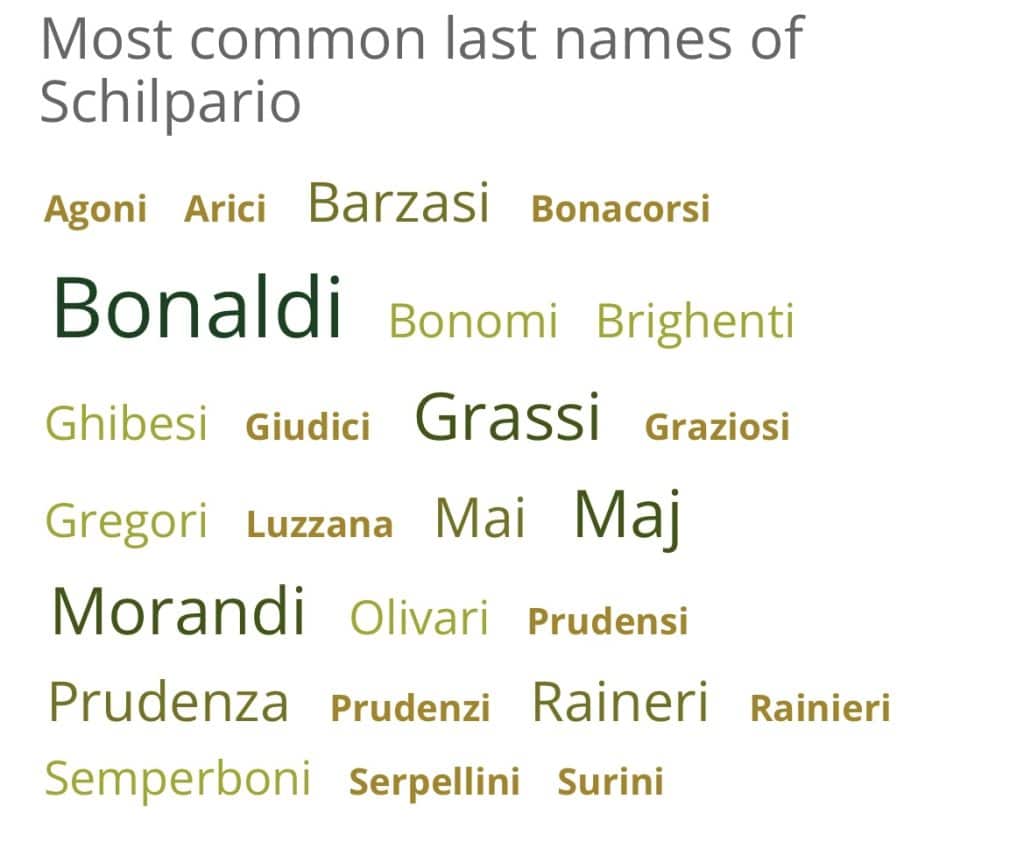Ciao Italianista contains affiliate links and is a member of the Amazon Services LLS Associates Program. If you make a purchase using one of these Amazon links, I may receive compensation at no extra charge to you. See my disclosure policy for more information.
Finding Angela – My Italian Genealogy Research Reveals an Amazing Discovery

My Italian genealogy research reveals an amazing discovery and more questions in my quest to find my Italian roots
Finding Angela is a sequel to my Italian genealogy research in Searching for Giuseppe. For the last 35 years, I have been consumed by discovering where my ancestors came from in Italy. Why is this important? Why does anyone want to know where they came from?
It’s important to me because, for some reason when I was 18, I fell in love with Italy, the Italian language, and all things Italian. So naturally, I would love to know exactly where my family came from in Italy.
My great-grandfather and great-grandmother were both born in Italy but met, married, and had children together in Brooklyn. I have gone down many paths, but all my searches for their lives before arriving in Brooklyn have always ended in dead ends and lost hope. Until now.
My Italian genealogy research has focused only on Forelli
I had always focused my family searches on my great-grandfather Giuseppe Forelli because he has the same last name as my grandfather, my father, and me. On the other hand, Angela’s last name was so inconsistent in the records that I could never be certain of what her name actually was. Her first name was either Angela or Angelina. And her last name showed up as Grassi, Grossi, Grazia, Di Grazia, Di Grassi, and Graffi.
So it was a huge surprise when I suddenly found, not Giuseppe, but Angela. How did this happen?
Imagining Angela
A few weeks ago I began imagining Angela. As she grew in my imagination, she suddenly came to life in the records. Within a few days of searching for Angela, I found her. I couldn’t believe it! Once I knew for certain where she was born, the records started revealing so many more facts to me including her parents’ names, and the names of her mother’s parents.
My imagination was sparked when I read the book Where You End, I Begin by Rossana Weitekamp. This is a fascinating story about an Italian man who emigrates to Brooklyn from Procida, an island off the Amalfi Coast. Nico Dioguardi leaves Procida after being rejected by his true love. He starts a new life in Brooklyn and gets married in order to be able to stay in this country. He didn’t love his new wife in the way that he loved Rosa in Italy and this often causes him to erupt into violence over and over against his wife and children. The novel really affected me and made me start imagining my great-grandmother Angela and wondering what her story was.
As soon as I turned my attention to Angela, I discovered the key that had been lying in plain sight the whole time. The key is a child named Pietro Spada. I had always seen Peter Spada listed as a household member on the 1910 census records for my great-grandfather, but I assumed Peter Spada was the son of my great-grandfather’s current wife in 1910 since Angela had died in 1905. So I never paid much attention to him.
However, once I started imagining Angela, I realized Peter Spada was actually her first child from her first husband. Realizing this was the piece that unlocked the puzzle.
The turning point came when I entered the name Pietro Spada and his birth year into the website Portale Antenati. My skin started tingling. There he was! The first record: Pietro Giò Maria Spada born in 1887 in Schilpario. Father: Giovanni Spada. Mother: Angela Grassi.

I knew without a shadow of a doubt that his mother, Angela Grassi, was my great-grandmother. Now I knew she had given birth to her first child in Schilpario. This means she was also born in Schilpario. Back then people were born and died in the same town generation after generation.
Italian genealogy research using the Portale Antenati registers
I was lucky that I found a record when I typed in Pietro Spada’s name. Usually, when you search by name, you won’t find what you are looking for. This is because the registers have not all been indexed yet. But if you know the exact town, you can browse the online images of registers themselves and look for your ancestors.
At first, the registers will overwhelm you. The scribes recorded everything in ancient cursive from the 1800s. Deciphering them seems impossible. Read the instructions on how to search for things in the Portale. This will help.
Once you get used to the cursive writing, you can usually read the names. I was almost thrown off by the old cursive s. It looks like an f. So Grassi looked like Grafsi. But I knew that was impossible, so I did some research and confirmed that when there were two s‘s, they made the first one long, like an f.
Now I am able to explore the online registers of Schilpario easily and I have made amazing discoveries about Angela. I found the records of her birth, her first marriage, her husband’s death, her parent’s marriage, and her mother’s death. From these records, I have confirmed her parents’ names and I even know the names of her mother’s parents.
Angela Grassi was first married to Giovanni Spada. Her mother’s name was Violante Mai. And Her grandmother’s name was Lucia Agoni. All these names, Grassi, Spada, Mai, and Agoni are the most common last names in Schilpario.

Within a few weeks, I have gone from not knowing where my family came from in Italy to discovering a town where they all have the same last names as my ancestors; and, their descendants, my relatives, probably still live there today. Are they also wondering what happened to their relatives who left?
Imagining Angela in Schilpario
Angela was a young mother in Schilpario, whose family had lived there for generations. Why would she, or anyone, want to emigrate from the beautiful Alps to Brooklyn in the 1880s? I typed this exact question into the internet and once again got chills.
Adriana Trigiani is a well-known writer who wrote a book called The Shoemaker’s Wife. The author’s great-grandparents also emigrated from Schilpario and also met in Hoboken, New Jersey. (My great-grandparents were married in Hoboken and moved there from Brooklyn.)
The Shoemaker’s Wife is a sweeping epic that begins in Schilpario and the Alps, then moves to Hoboken and Manhattan, and finally ends in Minnesota.
After reading this book, not only do I know the dates of the births, marriages, and deaths of my family members in Schilpario, but I also know what it was like to breathe the air, see the majestic views, and live daily life. I can imagine how every family had a pig to search for truffles in the forest. And that they had plenty of milk, cheese, bread, eggs, and berries in the spring and summer but that in the winter it was bitter cold and there was little to eat except for the cured meats and chestnuts in their root cellars.
Schilpario was one of the last villages to the north, which lay in the shadow of the Pizzo Camino, one of the highest peaks in the Alps, where the snow did not melt, even in summer. So high in the cliffs, the people looked down on the clouds, which moved through the valley like rosettes of meringue.
Adriana Trigiani – The Shoemaker’s Wife
I can also imagine that Angela’s first husband worked in the mines. Hard dangerous work that often killed people. Angela, suddenly a widow with a small child, decided to leave her small village in the Alps for a new life in America.
Schilpario was a mining town where rich veins of iron ore and barite were carved out of the earth and carted down to Milan for sale. Every job in the village was in service to the towns below, including the building and maintenance of the chutes that harnessed the rushing water of Stream Vò that was piped down the cliffs.
Adriana Trigiani – The Shoemaker’s Wife
Meeting Giuseppe in America
I imagine that Angela traveled not only with her son but also with her father. I can tell from the records that her mother had died when she was a year old and that her father was a witness at her second marriage to my great-grandfather in Hoboken.
When she arrived in Brooklyn with her father and young child, Angela would have sought others from her same northeastern area of the Bergamo province. Brooklyn and Hoboken were filled with immigrants from all over Italy, but as I learned in Where You End, I Begin, the Italians were not one homogenous group. In both neighborhoods and factories,
There were subsets that formed cliques containing people of similar province origin.
Rossana Weitekamp – Where you End, I Begin
So that means Giuseppe has to be from the Bergamo province. They would have both spoken a similar dialect, Bergamasca.
When Angela and Giuseppe met, did they fall in love? Did Angela need a husband to protect her and her child? Was it comforting to meet someone from the same area? Was Giuseppe in love? He was almost 30 when they met and married. Had he loved before? What happened? Why did he want to marry and start a family now?
And they did start a family. Peter Spada was already six when Giuseppe and Angela married. Then came Luigi, Anna Maria, Lena, Francesco (my grandpa), Caterina (who died as a baby), and Giovanni. Giovanni also died as a baby, one day after his mother Angela, in 1905.
Poor Giuseppe. All alone grieving the death of his wife and his baby. And now he has to take care of his stepson Peter, Luigi, Anna, Lena, and Francesco. Working as a laborer in Brooklyn, how could he do this? For a few months, he put his youngest children in the orphanage. Then Cherubia came from Italy and took care of the family as the new wife and mother.
Finding Angela makes me keep searching for Giuseppe in Italy
After finding Angela, I realized that Giuseppe had to have come from the same area. So I narrowed my search to any Forelli born in the Bergamo province. There are hardly any.
It is also very difficult to find Giuseppe because he was born in 1863 and the records are not online until 1866.
But I found a man named Battista Forelli from Molongo (now Casazza) who died in 1888. His parents are Luigi Forelli and Anna Forchini. Giuseppe’s parents’ names on his marriage certificate are Luigi Forelli and Anna Fortini. I am 99.9% sure these are the same people.
I emailed the church in Casazza asking for the baptism record of Giuseppe. They did not answer. Next, I will write to them properly and send some euros. I really want proof!
I also noticed on the marriage certificate that Giuseppe was a widower when he married Angela. Who was he married to? This would also give me the proof I’m looking for. The wedding record is almost always in the register of the bride’s town. I have looked through hundreds and hundreds of registers in all the towns near Casazza but I can’t find his previous marriage record. It’s literally looking for a needle in a haystack.
However, I did find very some very illuminating documents about Giuseppe’s father, Luigi. And now I also know why they are very few people with the last name Forelli in the Bergamo province, even though that is where Giuseppe came from.
Giuseppe’s father Luigi was an esposito
I was so excited when I found records for Giuseppe’s father Luigi. I happen to look in the Cittadinanze (immigration) registers for Mologno. And the very first record was a request by Luigi to change his residence from Mologno to Monasterolo di Castello (2 km away). The document called him Luigi Forelli Esposito. I couldn’t figure out why he had this other last name, Esposito.
Luigi filed a lot of paperwork with the Stato Civile in his life. I also found supporting documents for Luigi’s marriage to his second wife after his first wife Anna Maria (my great-great-grandmother) died. These documents included proof of Anna’s death and her dad’s name, the marriage banns, and the record of his baptism. All the documents called him Luigi Forelli esposito dell’ospedale di Bergamo.
Now I know this means that Luigi was an abandoned baby left at the hospital of Bergamo. So that’s it. That’s the end of the line. The reason there are so few Forellis where Giuseppe came from is because his father was a foundling. He was abandoned as a baby and later sent to the countryside to be raised by a peasant family. The family would have received a stipend for taking him in and he would start working for them as soon as he was old enough.
Who knows where the name Forelli came from? It did not come from his parents. No one knows who his parents were. It is simply a random name that didn’t exist in the area. Either someone gave him that random last name or he chose it himself when he was older.
Finding Angela high in the mountains was like a ray of sun shining through the Lombardian mist to reveal the shapes of my Italian ancestors working in the Bergamo countryside. But just as quickly the winter fog returned to shroud them in mystery.
Child Abandonment in Italy
I felt very depressed when I realized that Giuseppe’s father was an abandoned baby. All my life I have been trying to find out where my branch of the Forellis came from. After my initial elation of finding all these illuminating documents filed by Luigi, and finally knowing where Giuseppe came from, I felt a deep sadness. The search has come to an end because we really aren’t Forellis after all. There are 4 generations of Forellis in my branch and it is a made-up name for us.
Even though the entire town of Schilpario consists of the last names of my family on my great-grandmother Angela’s side going back for generations, I still felt so sad that I have nothing on Giuseppe’s side.
However, child abandonment in Italy is a fascinating subject in itself. I have learned some very interesting things. For example, child abandonment in Italy goes back to Roman times. At one point there were so many dead babies in the Tiber River in Rome, that the Pope had to create the system of the ruota.
La Ruota was a way for mothers of illegitimate babies to secretly give up their babies by placing them on a wheel on the outside of the church. The baby’s weight turns the wheel and they are received on the inside by the nuns. The baby is given to the wet nurse who hopefully is able to keep the baby alive.
At one point in the 1800s in Lombardy, 40% of babies were abandoned. Not all of them by unwed mothers. Many married couples also gave up their babies because they lived in such poverty that they could not provide for the new baby and their other children.
Also, most of the babies died. The fact that Luigi survived, grew up, got married (twice), and had a least four children (although 2 died as children) makes me feel better.
Now I also understand why Giuseppe left Bergamo in 1888. In 1888, Giuseppe was 25 years old. His father, mother, both brothers, and first wife had all died. He probably lived with other sharecropper families like in the film L’Albero degli Zoccoli (The Tree of the Wooden Clogs) directed by Ermanno Olmi.
This is a beautiful film that depicts the difficult and unfair life of the peasants working for landlords in the Bergamo countryside in the late 1800s. There is even a beautiful segment when a newlywed couple goes to Milan to stay with the bride’s aunt at a convent and consummate their marriage. The aunt who is a nun shows them the orphans and they return home with a new baby.
When one of the villagers says that maybe the baby was the son of a rich man, Priest Carlo answers,
Whether he was the son of a rich man or not, now he is a peasant and God will love him just the same.
Priest Carlo in the film The Tree of the Wooden Clogs
This film allowed me to understand what life was like for Giuseppe and why he would want to leave it all behind and leave no trace of himself for me to find.
Until I find his baptism or marriage record, I will always be searching for Giuseppe and imagining his life in Italy by reading and watching historical epic novels and films. However, now it is time to take a break from genealogy research and celebrate my finding Angela. I am already working on perfecting my delicious gnocchi dishes. And I’m planning my trip to Italy next year where I will first go to Angela’s village above the clouds and mingle with my living ancestors in Schilpario before slowly driving down the mountain through Sovere (his mother’s village) and Mologno (Casazza) always searching for Giuseppe.

